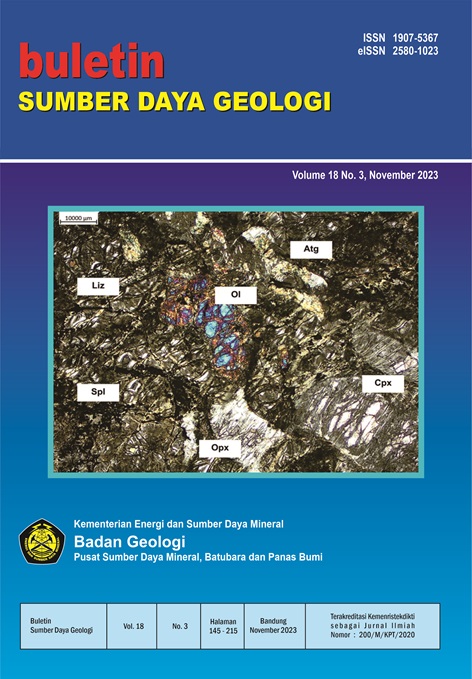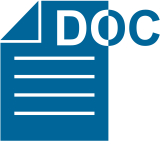DERAJAT LATERITISASI DAN PENGAYAAN UNSUR FE-NI-CO PADA BATUAN HARSBURGIT DI PULAU SEBUKU, KALIMANTAN SELATAN
DEGREE OF LATERITIZATION AND ENRICHMENT OF FE-NI-CO ELEMENTS IN HARSBURGITE ROCKS ON SEBUKU ISLAND, SOUTH KALIMANTAN
Abstract
The tropical climate in Indonesia causes a high level of chemical weathering or lateritization of ultramafic rocks which results in the enrichment of economic elements such as Fe, Ni and Co. These elements accumulate in the limonite and saprolite zones. This research was conducted on Sebuku Island which composed of ultramafic rocks, especially harzburgite. This study aims to determine the effect of the degree of lateritization in the limonite, saprolite and bedrock zones on the enrichment of economic elements. A number of 95 samples collected from 9 drill holes and analyzed using XRF to determine the main elements and economic elements. The degree of lateritization is calculated from the SiO2 content divided by the total accumulation of SiO2, Al2O3 and Fe2O3 resulting the S/SAF index which describes the intensity of the chemical reaction. The lowest value of the S/SAF index indicates a higher degree of lateritization. Each limonite, saprolite and bedrock zone has S/SAF index values ranging from 0.16 to 58 (strong lateritization), 0.27 to 0.85 (medium lateritization-kaolinization) and 0.77 to 1.24 (mother rock). The zone with a strong degree of lateritization contains Fe levels between 36% to 51%, Ni 0.80% to 1.38% and Co 0.07% to 1.17%. The bedrock contains 4.86% to 7.99% Fe, 0.20% to 1.76% Ni and 0.005% to 0.015% Co. The degree of lateritization in the limonite zone is higher than the saprolite and bedrock zones. This is caused by the decomposition of silica minerals to form the iron and aluminum oxide-hydroxide bearing minerals. The degree of lateritization has a positive correlation with the enrichment of Fe and Co. However, the distribution of high Ni not correlated with the index of lateritization.
Downloads
References
Aquino, K., Arcilla, C., Schardt, C., & Tupaz, C. (2022). Linking Serpentinization and Weathering of Peridotite: A Study on the Mineralogical and Geochemical Evolution of the Sta. Cruz Nickel Laterite Deposit, Zambales, Philippines. Minerals 2022.
Butt, C. R., & Cluzel, D. (2013). Nickel Laterite Ore Deposits: Weathered Serpentinites. Elements Vol. 9, 123-128.
Marsh, E., Anderson, E., & Gray, F. (2013). Nickel-Cobalt Laterites—A Deposit Model. Chapter H of Mineral Deposit Models for Resource Assessment: Scientific Investigations Report 2010-5070-H.
Neraca Sumber Daya dan Cadangan Mineral dan Batubara Indonesia Tahun 2022. (2022). Bandung: Pusat Sumber Daya Mineral, Batubara, dan Panas Bumi, Badan Geologi.
Ogura, Y. (1977). Mineralogical Studies on the Occurrence of Nickeliferous Laterite Deposits in the Southwestern Pacific Area. Mining Geology.
Robb, L. (2020). Introduction to Ore-forming Processes. Oxford: John WIley & Sons.
Rollinson, H. R. (2014). Using geochemical data: evaluation, presentation, interpretation. Routledge.
Rustandi, E., Nila, E., Sanyoto, P., & Margono, U. (1995). Peta Geologi Lembar Kotabaru, Kalimantan Selatan Skala 1:250.000. Bandung: Pusat Penelitian dan Pengembangan Geologi.
Strekeisen, A. (1973). Plutonic Rocks: Classification and Nomenclature Recommended by the I.U.G.S. Sub-Commission on the Systematic of Igneous. Rocks, Geo, Times, 18, 26-30.
Taylor, R. M., Mckenzie, R. M., & Norrish, K. (1964). The mineralogy and chemistry of manganese in some Australian soils. Aust. Jour. Soil. Res. 2, 235-248.
Copyright (c) 2024 Buletin Sumber Daya Geologi

This work is licensed under a Creative Commons Attribution-NonCommercial-ShareAlike 4.0 International License.
Authors whose manuscripts are published agree to the following terms:
The publication rights of all journal manuscript materials published on the Buletin Sumber Daya Geologi website are held by the editorial board with the knowledge of the author (moral rights remain with the manuscript’s author).
The formal legal provisions for access to digital articles in this electronic journal are subject to the terms of the Creative Commons Attribution-ShareAlike (CC BY-SA) license. This means that Buletin Sumber Daya Geologi has the right to store, convert media/formats, manage in the form of a database, maintain, and publish the article without requesting permission from the author, as long as the author’s name is cited as the copyright holder.
Manuscripts published in both print and electronic formats are open access for educational, research, investigative, and library purposes. Beyond these purposes, the editorial board is not responsible for any violations of copyright law.















